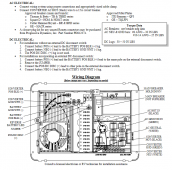Hello. I'm looking for some help planning the upgrade of my current rv electrical system.
Current setup is a 12v 100ah LifePO4 battery with bms. This is connected to a progressive dynamics all in one power distribution center. It contains ac, dc and charge controller. It is connected to a shore power plug for charging.
My plan for the short term is to charge the battery from a gas powered generator connected to the shore power plug.
The first thing I want to do is add a 1000w inverter. I don't understand how to tie this into my current setup.
As funds become available I will be adding solar panels for charging and will use the gas generator as backup for extended periods of reduced sun. I live in Central New York and get a lot of cloudy days. I will be using the rv seasonally for camping, not living in it full time. Although, camping trips to my 25 acre property may be for a couple of weeks at a time.
I also don't understand how I will tie solar into this setup, but my priority for right now is to get the inverter up and running.
At this point I'm considering the Renogy 1,000 watt pure sine wave inverter. I'm not sure if this is a decent choice but once I started looking at Victron inverters I started to get confused.
Any help would be greatly appreciated.
Current setup is a 12v 100ah LifePO4 battery with bms. This is connected to a progressive dynamics all in one power distribution center. It contains ac, dc and charge controller. It is connected to a shore power plug for charging.
My plan for the short term is to charge the battery from a gas powered generator connected to the shore power plug.
The first thing I want to do is add a 1000w inverter. I don't understand how to tie this into my current setup.
As funds become available I will be adding solar panels for charging and will use the gas generator as backup for extended periods of reduced sun. I live in Central New York and get a lot of cloudy days. I will be using the rv seasonally for camping, not living in it full time. Although, camping trips to my 25 acre property may be for a couple of weeks at a time.
I also don't understand how I will tie solar into this setup, but my priority for right now is to get the inverter up and running.
At this point I'm considering the Renogy 1,000 watt pure sine wave inverter. I'm not sure if this is a decent choice but once I started looking at Victron inverters I started to get confused.
Any help would be greatly appreciated.




